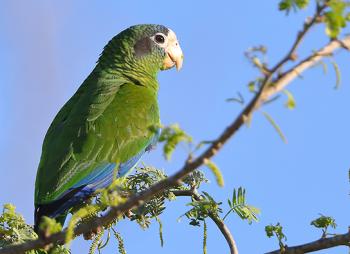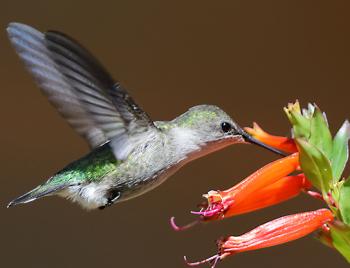Birding in the Dominican Republic
This item appears on page 14 of the September 2021 issue.
Originally, I was scheduled on a March 2021 trip to snorkel with humpback whales at the Silver Bank, near the Dominican Republic. I had arranged to do some birding with another company, Explora Ecotour (exploraecotour.com), prior to snorkeling. The snorkeling part of the trip was canceled due to COVID, but I realized I still wanted to visit the Dominican Republic.
I sent an email to Explora Ecotour asking if they could accommodate me for a longer birding trip. Manny Jimenes, co-owner and guide, responded promptly and asked for a few days to see if he could rearrange his other commitments. He was able to accommodate me for a 7-day, 6-night tour plus an additional two days and one night in another area.
The cost for the nine days of touring was $3,386, which included accommodations, transportation, all meals and water.
I would arrive in Santo Domingo on March 14, take the first tour March 15-21 and the second, March 22-23, then explore the city on my own until flying out in the early a.m. on March 27.
Manny was my guide, and he did an amazing job! At most sites, he also had local guides who were great at finding the birds.
Because the entire snorkel season (not just my own trip) had been canceled, United Airlines had canceled my return flight from Puerto Plata, the end point of my original trip. I called United to see if I could keep the same flight reservation but change the return to be from Santo Domingo. They did this at no additional cost.
•
Originally, through Booking.com, I had booked my first night in Santo Domingo at El Beaterio Casa Museo (Calle Duarte 8), a wonderful, small hotel in the middle of the historic district Ciudad Colonial. Formerly a convent, it was built in the 1500s.
I was given a room on the ground floor, as I’d requested. The room was spacious and the Wi-Fi, excellent. The staff went above and beyond to make my stay comfortable.
The room rate ($103 per night) included a full hot breakfast, which had to be ordered the previous day. I had also booked a night there between the two birding tours plus three more nights after the trip.
There were no special requirements for entering the country during COVID, but there was a mask requirement in Santo Domingo. I would say that probably 80% of the people were masked up, even outdoors. A higher percentage were masked indoors at the grocery store, two blocks from the hotel, and in the restaurant El Buho Café (Calle Arzobispo Nouel 58), one block from the hotel.
I ate at El Buho whenever I ate out. Each person’s temperature was taken as they entered the restaurant. All staff members wore masks. Tables were separated, and each had a bottle of hand sanitizer. There was covered outdoor dining as well. I felt totally safe eating there. Meals cost $10-$15.
All of Santo Domingo’s stores seemed to be open, as were museums and other tourist attractions.
•
Manny met me at the agreed-upon time my first day, and we headed out. It was evident that the vehicle had been thoroughly cleaned, and we wore masks while in the car.
Our first stop was the ruins of the first hospital in Santo Domingo, where the attraction was Hispaniolan parakeets (endemic to the island). I got some excellent photos.
Heading from there to Sierra de Bahoruco National Park, in the southwest of the country, the drive took several hours. We stopped for lunch at a fast-food chicken restaurant. All staff and customers wore masks except when eating.
At Villa Barrancolí (phone +1 849 205 0882, www.todytours.com/en/villa-barrancoli), on the edge of the park, cabins were rustic, with a shared central bathroom.
The lodge’s location was great, but the property really needed some maintenance. There just weren’t any other convenient options for lodging.
After checking in, Manny and I headed out with a local guide. While the locals weren’t masked, the guide wore a mask when in the car and when walking closely to me. We quickly found more endemic birds.
During my three days at the lodge, we visited a cloud forest at Zapotén (where I photographed the La Selle thrush and Hispaniolan trogon) and looked for birds on farmland around the park. The rough road to the cloud forest went along Haiti’s border. While in Haiti, I was able to photograph the Antillean piculet, another hard-to-find bird.
Just as the guide was telling me I probably wouldn’t be able to see a Hispaniolan parrot in the open, one flew to the top of a small tree 20 feet away, staying long enough for me to get pictures. We also visited the Loma Charco Azul Biological Preserve.
After leaving the Bahoruco park, we spent a night in a small hotel in a small town. The room was nicer than my cabin at the Eco Lodge.
In the morning, we looked for shore birds near the hotel, headed back to Santo Domingo for a night at El Beaterio, then headed to Los Haitises National Park in the northeast. The lodge at the park was beautiful, and my room there was the best one on the trip up to that point.
The attraction at Los Haitises is the endangered Ridgeway’s hawk. We found it on our first day there and again with the local guide the following morning, along with numerous other birds. Our return to Santo Domingo marked the end of the 7-day tour.
The next morning, Manny and I headed to Ebano Verde Scientific Reserve, in the middle of the country and named after a tree found only in that area. We stayed at the park lodge, which was quite new and had only four suites. My room was amazing, with a balcony on which I could set up my camera.
Our hike the next morning wasn’t very productive for birds, but I set up at a flowering shrub near the park office and got an excellent shot of a Vervain hummingbird. In all, on this trip, I think I saw almost every bird endemic to the Dominican Republic.
We then returned to Santo Domingo.
•
My next challenge was to get a COVID test, since that was required to board a plane to the US. Though I had packed a list of labs I’d found on the Dominican Republic site www.drtravelcenter.com, I asked the staff at El Beaterio for suggestions. They suggested I go to the lab they use for testing staff, since the larger labs would be more crowded. They called a taxi for me.
The ride should have taken 20 minutes, but the driver couldn’t find the lab and wouldn’t talk to the hotel staff when I called them for help. He kept stopping and asking for directions. After an hour, he found the lab.
I was told that someone at the lab would speak English, but none did very well. I called the hotel, and they explained to the clinic staff what I needed. After about 30 minutes, I walked out with my certificate of a negative test. The driver had waited and returned me to the hotel.
The next morning, the hotel manager walked up, apologized for the problems I’d experienced the previous day and paid for the taxi ride. I tried to refuse the money, since the hotel was small and I knew they weren’t full, but she insisted.
If I return to Santo Domingo, I will definitely stay at El Beaterio Casa Museo.
On the flight home, there were no empty seats, but everyone followed the masking rules.
I’m glad I decided to take the trip.
MARIAN HERZ
Boise, ID


